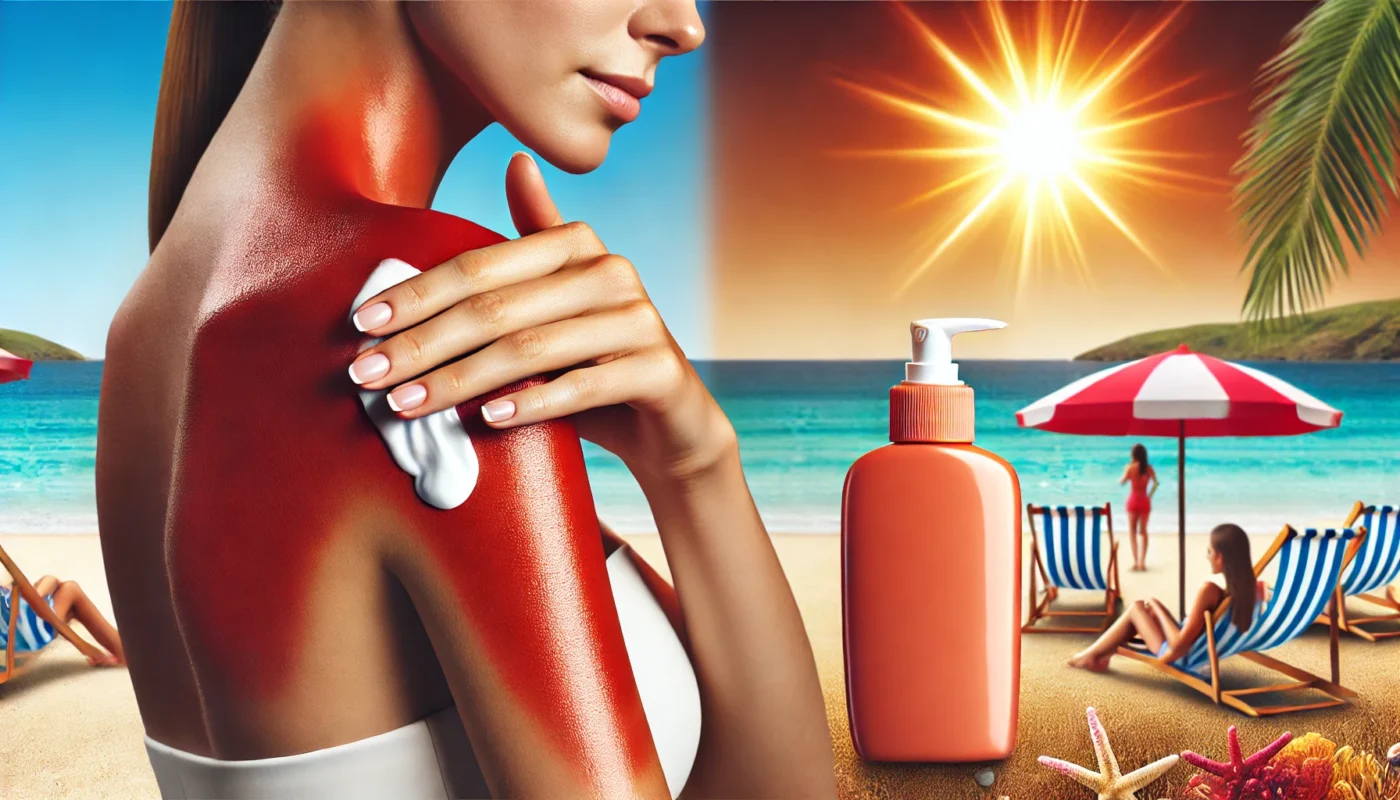To understand the transition from sunburn to tan, it’s essential to first comprehend what exactly happens to your skin during sun exposure. When your skin is exposed to UV rays, it triggers a response from melanocytes, the cells responsible for producing melanin—the pigment that gives skin its color. Melanin acts as a natural defense mechanism, absorbing and dispersing UV rays to prevent further damage.
You may also like: Essential Tips for Sun Protection Daily
The Role of Melanin
Melanin is not just a pigment; it plays a critical role in protecting your skin from UV damage. When UV rays penetrate the skin, they can cause mutations in the DNA of skin cells. Melanin absorbs these harmful rays, reducing the risk of such mutations and, consequently, skin cancer. However, the production of melanin varies among individuals, which is why some people tan easily, while others burn.
Skin Types and Their Responses
Understanding your skin type is crucial in predicting how it will respond to sun exposure. Skin types are categorized from I to VI, with Type I being very fair skin that burns easily and tans minimally, and Type VI being very dark skin that rarely burns and tans deeply. Knowing your skin type can help you take appropriate precautions when exposed to the sun.
The Healing Process Post-Sunburn
After a sunburn, the skin undergoes a healing process that includes inflammation, repair of damaged cells, and, in some cases, increased melanin production. This process is your skin’s way of recovering from the damage and providing additional protection against future UV exposure. However, relying on this process for tanning is not without risks.
Do Sunburns Turn into a Tan?
A common question is, “Do sunburns turn into a tan?” The answer lies in the skin’s healing process. When you get sunburned, your skin has already sustained damage. The redness and inflammation are signs of this injury. However, as the skin begins to heal, it may produce more melanin, which can lead to a tan. This process, however, is not guaranteed and varies significantly among individuals based on skin type and genetic factors.
The Risk of Relying on Sunburns for Tanning
While some might notice a tan after a sunburn heals, this should not be a tanning strategy. Sunburn indicates that the skin has been damaged, which increases the risk of long-term issues like skin cancer and premature aging. Relying on sunburns for tanning can lead to cumulative damage over time, making it a dangerous approach.
Factors Influencing the Transition
Several factors influence whether a sunburn will eventually result in a tan. These include the intensity of the UV exposure, the individual’s skin type, and the body’s natural healing process. Genetics also play a role, as some people are genetically predisposed to tan more easily than others.
Individual Variability in Tanning
The variability in tanning response means that two people with the same level of sun exposure might have completely different outcomes. For some, a sunburn may lead to peeling without any tan, while others may develop a tan as their skin heals. Understanding this variability can help set realistic expectations and encourage safer sun practices.
The Risks of Sunburn and Long-term Skin Damage
Before we delve into how to transition safely from sunburn to tan, it’s crucial to acknowledge the risks associated with sunburn. The immediate effects include redness, pain, and peeling, while long-term consequences can be more severe. Repeated sunburns increase the risk of skin cancer, accelerate skin aging, and can lead to other dermatological issues.
Immediate Effects of Sunburn
The first signs of sunburn are often redness and pain, which can appear within a few hours of sun exposure. This inflammation is the body’s response to the DNA damage caused by UV rays. As the skin continues to repair, peeling may occur, which is the body’s way of shedding damaged cells.
Long-term Consequences of Sunburn
Beyond the immediate discomfort, sunburns can have serious long-term effects. They can significantly increase the risk of skin cancers such as melanoma, basal cell carcinoma, and squamous cell carcinoma. Sunburns also contribute to photoaging, which manifests as wrinkles, loss of skin elasticity, and pigmentation changes.

The Cumulative Effect of UV Damage
Each sunburn can add to the cumulative damage your skin experiences over time. This cumulative damage not only increases cancer risk but also affects the skin’s overall health and appearance. Understanding the long-term impact of sunburns can motivate better sun protection habits.
How Long Till Sunburn Turns to Tan?
The timeline for a sunburn to transition into a tan, if it does at all, varies. Generally, it can take anywhere from several days to a week for the skin to start tanning as it heals. However, this is contingent upon the degree of the burn and individual skin responses.
Influencing Factors on Tanning Timeline
Several factors can influence how quickly a sunburn may transition to a tan. These include the severity of the sunburn, the individual’s skin type, and their genetic predisposition to tan. Additionally, external factors such as ongoing sun exposure and skincare practices can also play a role.
Managing Expectations for Tanning
It’s important to manage expectations when it comes to tanning after a sunburn. Not every sunburn will result in a tan, and for some, the skin may simply peel without tanning. Understanding these possibilities can help individuals adopt safer sun habits rather than relying on sunburns for tanning.
Variability in Skin Healing
The variability in how skin heals from sunburn means that each person will have a different experience. Some may notice a tan forming as their skin heals, while others may find their skin returns to its original shade. Recognizing this variability underscores the importance of individualized sun care.
Strategies for a Safe Transition from Sunburn to Tan
Immediate Aftercare for Sunburn
- Cool the Skin: As soon as you notice a sunburn, take immediate steps to cool down your skin. Use cold compresses or take a cool shower to reduce inflammation. Cooling the skin not only provides relief but also helps minimize further damage to the affected area.
- Hydration is Key: Sunburn dehydrates your skin, so it’s vital to replenish lost moisture. Drink plenty of water and apply aloe vera or a moisturizer containing hyaluronic acid. Keeping the skin hydrated aids in the healing process and reduces the risk of peeling.
- Avoid Further Sun Exposure: Give your skin time to heal. Stay out of the sun until the redness and pain have subsided, typically around 3-7 days. Avoiding additional UV exposure during this time is crucial to prevent further damage.

Gradual and Safe Tanning Practices
Once your skin has healed from the sunburn, you can start adopting safer tanning habits.
- Use Sunscreen: Apply a broad-spectrum sunscreen with an SPF of at least 30. It may seem counterintuitive, but sunscreen doesn’t prevent tanning; it filters UV rays to prevent burning. Regular use of sunscreen allows for a gradual and safer tan by protecting the skin from intense UV exposure.
- Limit Sun Exposure: Gradually increase your time in the sun to allow your skin to adapt. Start with short periods and slowly extend them over time. This approach helps the skin build a natural defense without causing damage.
- Seek Shade: Take breaks in the shade to prevent overexposure and allow your skin some respite. Alternating between sun and shade reduces the risk of burning and supports a healthier tanning process.
- Wear Protective Clothing: Use hats, sunglasses, and lightweight long-sleeved shirts to protect your skin when UV rays are at their peak. Protective clothing acts as a physical barrier against harmful rays, ensuring your skin is less exposed to potential damage.
Alternative Tanning Methods
For those looking to achieve a tan without risking sun damage, consider alternative methods:
- Self-tanning Products: These are safer options that do not involve UV exposure. Opt for lotions, sprays, or mousse that contain dihydroxyacetone (DHA), which temporarily darkens the skin. Self-tanners offer a customizable tan without the risks associated with sun exposure.
- Spray Tans: Professional spray tans offer an even application and can be customized to your desired shade. Spray tans are a quick and effective way to achieve a sun-kissed look without the need for sunbathing.
- Tanning Tablets: Some supplements claim to enhance tanning by increasing melanin production from within. While results may vary, these products can be an alternative for those seeking a gradual tan without sun exposure.
Embracing a Holistic Approach to Skin Health
Finally, transitioning from sunburn to tan should always prioritize skin health. Consider holistic approaches that support skin recovery and enhancement:
- Antioxidant-rich Diet: Foods high in antioxidants, such as berries and leafy greens, help combat free radicals generated by UV exposure. A diet rich in antioxidants supports the skin’s defense mechanisms and promotes overall health.
- Hydration: Maintain skin hydration from the inside out by drinking ample water and consuming hydrating foods like cucumbers and watermelon. Adequate hydration is essential for skin elasticity and repair, especially after sun exposure.
- Supplements: Consider supplements like beta-carotene, which may enhance the skin’s resilience to sun exposure. Supplements can provide additional support in maintaining healthy skin and preventing damage.
- Regular Skin Checks: Perform regular self-examinations of your skin to catch any early signs of damage or changes. Early detection of skin issues can lead to more effective treatment and prevention strategies.
- Consulting a Dermatologist: Regular visits to a dermatologist can help maintain skin health and address any concerns related to sun exposure or tanning practices. Professional advice ensures you are following the best practices for your skin type.

Conclusion: Balancing Beauty and Health
In summary, while the prospect of transitioning from sunburn to tan is tempting, it is essential to approach this process with caution. Prioritize skin health by adopting protective measures and understanding the risks associated with UV exposure. By incorporating safe sun habits, utilizing alternative tanning methods, and embracing a holistic approach, you can enjoy a healthy glow while minimizing potential damage.
Remember, a tan should never come at the expense of your skin’s health. Always strive for a balance that ensures both beauty and wellbeing. By making informed choices and prioritizing skin health, you can achieve a radiant appearance without compromising your safety.
Further Reading:
How to treat sunburn and everything else you need to know about them
How to Turn a Sunburn into a Tan (Plus, Is It Even Possible?)
sunburn, suntan, sun exposure, skin health, tanning tips, melanin, UV protection, skin care, sunburn treatment, safe tanning, skin types, tanning products, alternative tanning, skincare routine, dermatology.
Important Note: The information contained in this article is for general informational purposes only, and should not be construed as health or medical advice, nor is it intended to diagnose, prevent, treat, or cure any disease or health condition. Before embarking on any diet, fitness regimen, or program of nutritional supplementation, it is advisable to consult your healthcare professional in order to determine its safety and probable efficacy in terms of your individual state of health.
Regarding Nutritional Supplements Or Other Non-Prescription Health Products: If any nutritional supplements or other non-prescription health products are mentioned in the foregoing article, any claims or statements made about them have not been evaluated by the U.S. Food and Drug Administration, and such nutritional supplements or other health products are not intended to diagnose, treat, cure, or prevent any disease.

